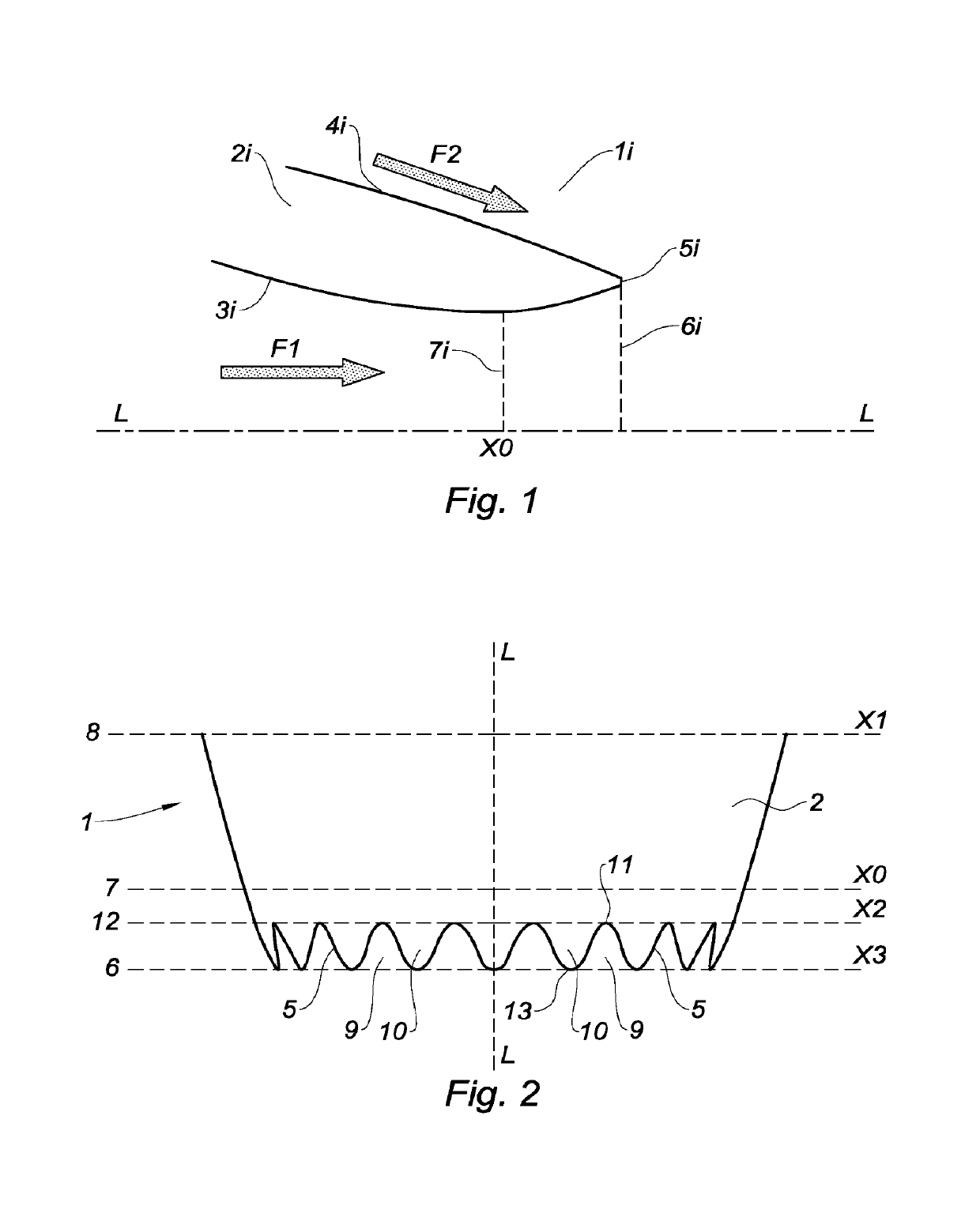Nozzle of a turbomachine provided with chevrons with a non-axisymmetric inner face
a turbomachine and inner face technology, applied in the direction of machines/engines, mechanical equipment, transportation and packaging, etc., can solve the problems of inconvenient incorporation of anti-noise chevrons in the trailing edge region of the nozzle, noise, and generally designated as “jet noise” and other problems, to avoid disruption of internal flow, avoid recirculation, and improve the re-entrant nature of the chevrons
- Summary
- Abstract
- Description
- Claims
- Application Information
AI Technical Summary
Benefits of technology
Problems solved by technology
Method used
Image
Examples
first embodiment
ENT-DIVERGENT REFERENCE NOZZLE
[0052]When the cowl does not surround a central body, the rotationally symmetric cross-section of the nozzle around an axis L-L is defined by a cross-section perpendicular to the axis L-L. The surface area of a cross-section is defined solely by the radius of the internal wall of the cowl in this plane. Since the walls of the cowl are of circular cross-section, they are convergent or divergent here if the radius decreases or increases respectively in the downstream direction.
[0053]FIG. 1 shows a known convergent-divergent reference nozzle 1i of a single-flow turbine engine. The reference nozzle 1i comprises an annular reference cowl 2i having a longitudinal axis L-L and a certain thickness which decreases close to its trailing edge 5i. The internal wall 3i of the cowl 2i defines a nozzle through which an internal gaseous flow F1 passes. The external wall 4i of this cowl 2i is in contact with an external gaseous flow F2.
[0054]The internal 3i and external...
second embodiment
NCE NOZZLE
[0108]In this variant, the reference nozzle 1i is simply convergent. An attempt will then be made to reduce the effect of supplementary convergence introduced by chevrons.
[0109]The cowl 2 of the nozzle obtained according to the present invention has, towards its trailing edge 5, a shape comprising chevrons 10 and indentations 9, which is defined by the same parameters as those of the first embodiment.
[0110]In this case there is no predefined neck, since the reference nozzle is convergent. A preliminary step therefore consists in choosing a cross-section 7, for an abscissa X0 on the axis L-L upstream of the outlet 6i of the reference nozzle 1i, on the basis of which the shape of the internal wall 3 of the cowl 2 of the optimised nozzle is modified. Once this abscissa X0 is determined, the construction of the surfaces defining the internal 3 and external 4 walls of the cowl 2 uses the same parameters and the same method as for the first embodiment.
[0111]The method for defini...
third embodiment
E NOZZLE
[0113]In the case of an exhaust nozzle for a double-flow turbojet engine for example, the nozzle corresponds to the air conduit defined between the internal wall of a cowl 2 and the wall 21 of a central body 20 of circular cross-section around the axis L-L shown in FIG. 6.
[0114]The cross-section of the nozzle is no longer defined by the radius of the internal face of the cowl 2. Known methods are used in this configuration and define, as the cross-section, a surface which is substantially perpendicular to the mean flow, which is no longer a plane perpendicular to the axis L-L. For example, the calculation method known as “rolling ball” consists in making a ball roll on one of the walls. When this ball touches the two walls, the line which joins the two points of contact defines the passage cross-section between these two points. By varying the diameter of the ball it is thus possible to define the passage cross-section over the length of the nozzle. Next, the convergent or d...
PUM
 Login to View More
Login to View More Abstract
Description
Claims
Application Information
 Login to View More
Login to View More - R&D
- Intellectual Property
- Life Sciences
- Materials
- Tech Scout
- Unparalleled Data Quality
- Higher Quality Content
- 60% Fewer Hallucinations
Browse by: Latest US Patents, China's latest patents, Technical Efficacy Thesaurus, Application Domain, Technology Topic, Popular Technical Reports.
© 2025 PatSnap. All rights reserved.Legal|Privacy policy|Modern Slavery Act Transparency Statement|Sitemap|About US| Contact US: help@patsnap.com



